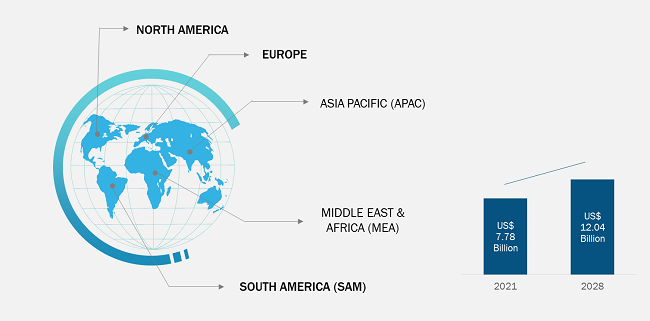Growth in Incidences of Diabetes Supports Diabetic Retinopathy Market
According to our latest market study on "Diabetic Retinopathy Market Forecast to 2028 – COVID-19 Impact and Global Analysis – by Type, Treatment, Distribution Channel, Application, and Geography," the market is expected to grow from US$ 7.78 billion in 2021 to US$ 12.04 billion by 2028; it is expected to grow at a CAGR of 6.5% from 2022 to 2028.

Diabetic Retinopathy Market Size, Share, Scope Analysis 2031
Download Free SampleDiabetic Retinopathy Market Size and Forecasts (2021 - 2031), Global and Regional Share, Trends, and Growth Opportunity Analysis Report Coverage: by Type (Proliferative Diabetic Retinopathy and Non-Proliferative Diabetic Retinopathy), Treatment (Anti-VEGF Drug, Steroid Injection, Laser Surgeries, and Vitrectomy), and Distribution Channel (Retail Pharmacies, Hospital Pharmacies, and Others), and Geography (North America, Europe, Asia Pacific, and South and Central America)
The rising incidence of diabetes, the growing geriatric population, increasing cases of diabetic retinopathy, increasing demand of retinal screening among the long-term diabetic patients and technological advancements in medical treatments are boosting the diabetic retinopathy market growth. However, slow drug approval and a lack of skilled ophthalmologists are hampering the growth of the market.
Diabetic retinopathy is characterized by blurred vision and blindness as high sugar level damage the retina. According to the Centers for Disease Control and Prevention (CDC) data, diabetic retinopathy affects approximately one-third of the people with diabetes over the age of 40 years, and more than 4.2 million patients are currently living in the US with diabetic retinopathy. As a result, the market leaders are working on developing innovative treatments for diabetic retinopathy, and a wide variety of new related treatments are under investigation. Moreover, diabetes is one of the most commonly diagnosed noncommunicable diseases, and the increasing incidence of diabetes has contributed to the growth of the diabetic retinopathy market. According to the International Diabetes Federation (IDF) data, the number of diabetic patients is expected to grow from ~537 million in 2021 to 643 million by 2030.
Moreover, the healthcare expenditure has created ample opportunities for developing nations to provide better services and facilities to their citizens. Adoption of available treatments, including anti-VEGF drugs, steroid injection, laser surgeries, and vitrectomy, is likely to rise in emerging regions such as Asia Pacific and Middle East & Africa. These regions are investing a significant amount in their healthcare sectors; as a result, health awareness has notably increased. Additionally, the increasing incidence of other diabetes-associated risk factors such as obesity, glucose intolerance, insulin resistance, and polycystic ovary syndrome are boosting the growth of the diabetic retinopathy market. Further, increasing awareness about diabetic retinopathy results in a sudden rise in the diagnostic rates of the disease, which ultimately increase the demand for available treatments. The anti-VEGF drugs seem to be the most effective treatment for diabetic retinopathy and are currently prescribed as first-line treatment.
Based on type, the diabetic retinopathy market is bifurcated into proliferative diabetic retinopathy and non-proliferative diabetic retinopathy. The non-proliferative diabetic retinopathy segment accounted for a larger market share in 2021 and is expected to retain its dominance during the forecast period. For instance, in May 2019, Regeneron Pharmaceuticals, Inc. received FDA approval for EYLEA® (Aflibercept) Injection for the treatment of diabetic retinopathy. However, the proliferative diabetic retinopathy segment is expected to witness a higher CAGR from 2022 to 2028.
Based on application, the diabetic retinopathy market is segmented into anti-VEGF drugs, steroid injections, laser surgeries, and vitrectomy. The anti-VEGF drugs segment accounted for the largest market share in 2021, and it is expected to dominate the market over the forecast period. Moreover, drugs such as Pegaptanib, Bevacizumab, Ranibizumab, and Aflibercept are currently available anti-VEGF candidates for the management of diabetic retinopathy, while few of the candidates are under investigation, and many new candidates are expected to receive approval. Drugs such as Runcaciguat and OTT166 demonstrate superior results in clinical trials in the treatment of diabetic retinopathy.
Based on distribution channel, the diabetic retinopathy market is segmented into retail pharmacies, hospital pharmacies, and others. The retail pharmacies segment accounted for the largest market share in 2021, and it is expected to dominate the market over the forecast period. However, the hospital pharmacies segment is expected to witness the highest CAGR from 2022 to 2028
Abbott Laboratories, Alimera Science, Allergan Plc, Ampio Pharmaceuticals, Bayer AG, F. Hoffmann-LA Roche, Novartis International AG, PFIZER, Regeneron Pharmaceuticals Inc, and Valeant Pharmaceutical are a few of the key market players profiled during the study. Several other major companies were analyzed during this study to get a holistic view of the diabetic retinopathy market.
Contact Us
Phone: +1-646-491-9876
Email Id: sales@theinsightpartners.com